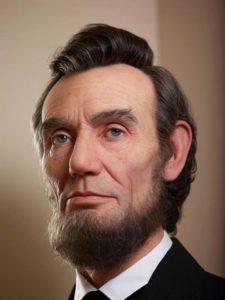 Abraham Lincoln was working in his second floor office on February 10, 1864 when he realized the White House stables were on fire.
Abraham Lincoln was working in his second floor office on February 10, 1864 when he realized the White House stables were on fire.
It had been a long day already. Lincoln had spent the morning reviewing court martial cases, desperately searching for a reason to suspend the mandatory death sentence for deserters and working to keep soldiers in the army. Shortly after a light lunch of strawberries and milk, he had open office hours where the public could come in to vent their individual views. Lincoln called these his “public opinion baths,” which while distracting from more important work, helped him understand public sentiment. “Public sentiment is everything,” Lincoln had said. “With it we can accomplish anything; without it, nothing.” Later in the afternoon Lincoln received a delegation of 18 men from a convention at Allegheny City, Pennsylvania. They wanted to amend the Constitution “in favor of freedom.”
But then around 8:30 pm there was smoke. Lincoln’s private stables were on fire. He could see the small brick building between the White House and the the Treasury Building next door. Rushing out, his intent was to put out the fire but it was already consuming the small stables. Robert McBride recalled the event, which was also reported in the Evening Star newspaper:
“[Mr.] Cooper, the President’s private coachman, left the stable to get his supper about 8 o’clock, and he was first notified of the fire by the President himself, who discovered the smoke . . . The building . . . contained . . . six horses, all of which were burned to death . . . One of these ponies was all the more highly prized, in consequence of having once been the property of Willie, the deceased son of Mr. and Mrs. President Lincoln.”
Hours later, Lincoln stood in the East Room looking out at the still-smoldering stables. According to McBride, “Lincoln was weeping. Tad explained it was because Willie’s pony was there.”
Willie, Lincoln’s second oldest son, had died of typhoid almost exactly two years before, right here in the White House. The pony was the last remnant of the boy’s life remaining. Also lost were Lincoln’s own two horses, as well John Nicolay’s two horses and Tad’s other two ponies.
Lincoln conferred the next day with Commissioner of Public Buildings Benjamin Brown French about rebuilding the stables. Meanwhile, Patterson McGee, dismissed on the day the White House stables burned, was arrested the day after on the charge of having started the fire. He was released shortly thereafter.*
And the war continued.
*Edited to add McGee was cleared of wrongdoing. As Scott McCullagh in the comments alludes, McGee was released. Scott didn’t provide a source, but I’ve also heard via LinkedIn from historian and Lincoln scholar David Gerleman, who confirms McGee was released immediately after it was discovered he was in Grover’s Theater when the fire started. Gerleman says he has an in-depth article on the fire due out in 2022. Thanks to both for the additional information.
[Photo of Kazuhiro Tsuji sculpture of Lincoln, from The amazing story of Hollywood Make-up artist Kazuhiro Tsuji – Spoon & Tamago (spoon-tamago.com)]
David J. Kent is an avid science traveler and the author of Lincoln: The Man Who Saved America. His previous books include Tesla: The Wizard of Electricity and Edison: The Inventor of the Modern World and two specialty e-books: Nikola Tesla: Renewable Energy Ahead of Its Time and Abraham Lincoln and Nikola Tesla: Connected by Fate.
Follow me for updates on my Facebook author page and Goodreads.










